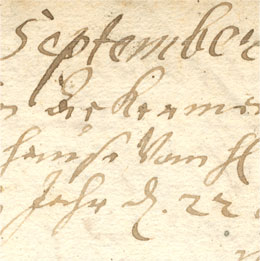When was the Vigala Church pulpit completed and who commissioned it?
The church’s new pulpit was completed in the latter half of the 1680s at about the same time as the independent master Christian Ackermann was occupied with carving the figural and ornamental décor of the Vigala Church retable. Hans Jürgen von Üxküll, an Oberst (equivalent rank of colonel) in the Swedish Army, the local Mannrichter (district court judge) and member of the Landrat (the provincial knighthood’s land council), and also the owner of Vigala and Pikavere manors, and his wife Marie von Plater were behind this commission. The coats-of-arms of both donors were mounted on the pulpit’s sounding board.
Where was the pulpit positioned?
The pulpit was commissioned for Vigala’s medieval church, the interior of which had been completely destroyed by fire in 1581 and which had been restored at the start of the 17 th century. The pulpit’s original location is not known. It is possible that it was situated in the nave on the southern side of the chancel arch. The relocated pulpit is currently located along the northern wall of the cavetto vaulted church hall between the two easternmost windows. The pulpit’s composition changed somewhat in the course of its relocation.
What do the pulpit’s figures speak of?
Judging by the types and cutting lines of the statues on the pulpit’s corpus and sounding board, it can be claimed that Ackermann did not carve them. Most of them were carved according to drawings used in the master’s workshop or by one of the master’s assistants alongside the master.
Judging by the types and cutting lines of the statues on the pulpit’s corpus and sounding board, it can be presumed that Ackermann did not carve them. Most of them were presumably carved by one of his assistants according to drawings used in the master’s workshop.
The objective of the pulpit’s iconographic programme was to proclaim the New Testament’s reliance on the Old Testament, the importance of the Gospel, the resurrection that followed Christ’s death, and everlasting life.
The pulpit’s corpus apparently originally had six figures: the apostles St. Paul and St. Peter, St. Luke the Evangelist, Christ as Salvator Mundi, Moses the Prophet, and presumably also St. John the Baptist (which was lost as a result of the later redesign of the pulpit). It is not known why St. Luke was the only one of the four evangelists to be represented. The mounting of Christ as Salvator Mundi to redeem the world on the pulpit’s corpus was a general rule.
What became of the pulpit after Ackermann and the cabinetmaker had finished their work?
After the cabinetmaker’s work and the carving work was finished, the painter coated the pulpit with paints, lustre, and gilding.
The completed pulpit was placed on the church’s southern side, from where it was evidently relocated to the northern side of the chancel arch in the 19th century. The pulpit’s composition was altered somewhat in the course of its relocation. At the same time, the pulpit lost one of its sides and together with it apparently the statue of St. John the Baptist. At the same time, the pulpit was given an entirely new colour scheme.
The original polychromy survived only on one side of the pulpit and a twisted colonnette, which was pushed against the church wall and for this reason was ‘spared’ from later painters.




